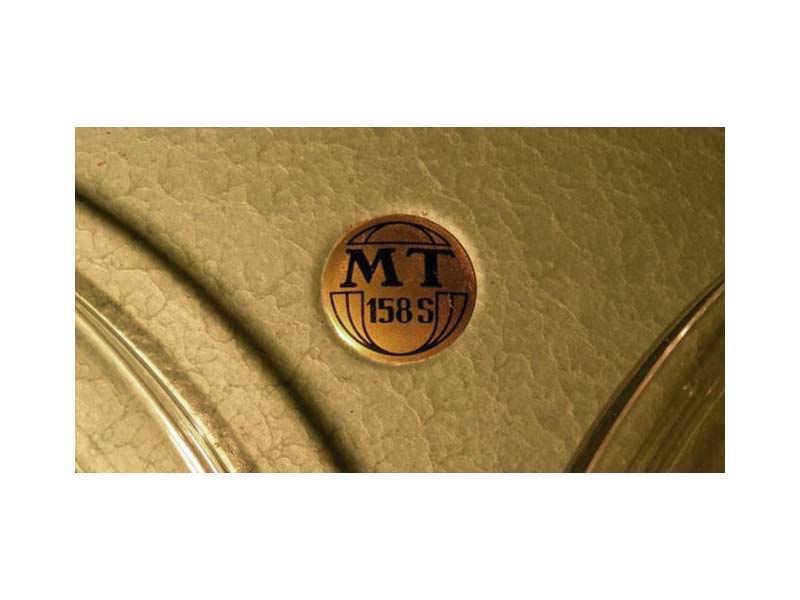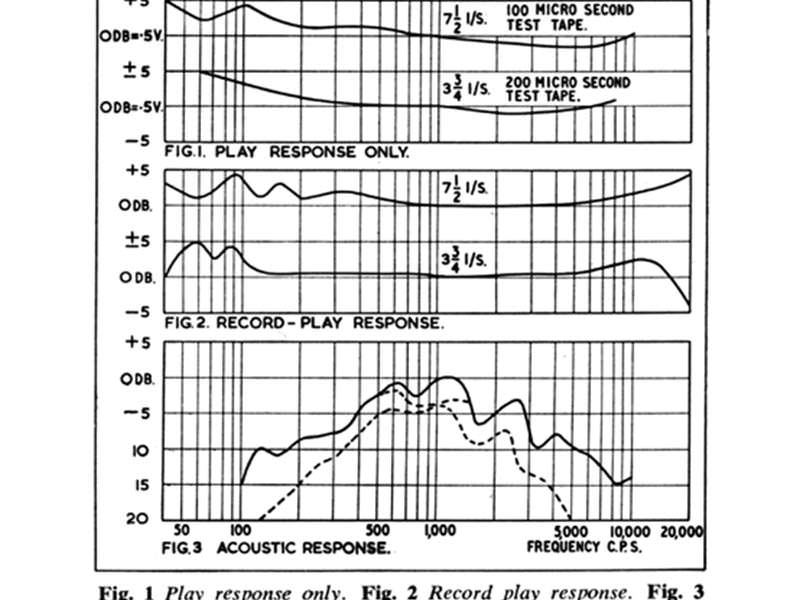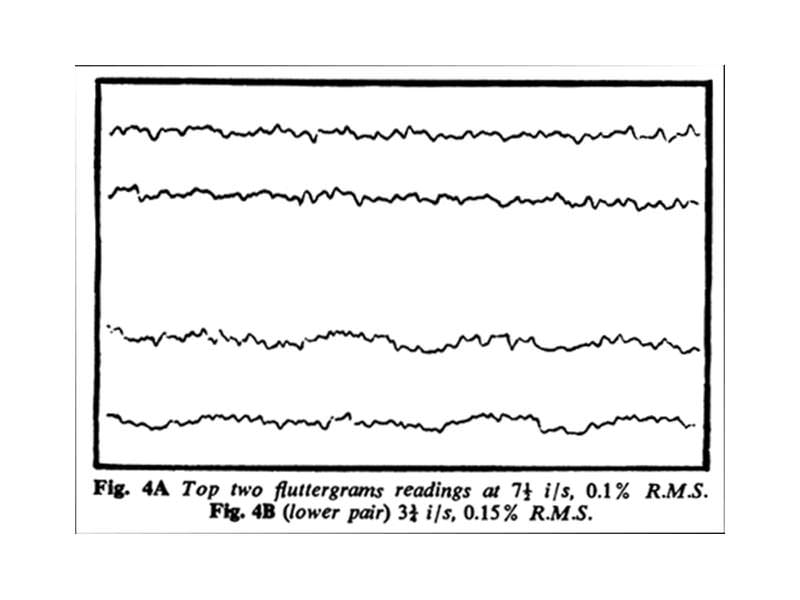Technical Details
Brand: Korting
Model:MT157
Category:Mid High Fidelity
Application:Consumer
Electronics:Tube
Equalization:IEC
Country of Manufacture:Germany
Release dates:1961 - 1964
Tracks:1/4 Rec/PB
Speeds: 3 3/4, 7 1/2
Max Reel Size("): 7"
Number of heads: 3
Head Composition: Permalloy
Head Configuration: Stereo
Voltage(s): 220-240v
Outputs: DIN
Frequency Response:7½ ips: 30Hz - 20kHz
Wow and Flutter:less than 0.2% at 7½ ips
Signal-to-Noise Ratio:better than 40dB
Sound quality rating:5 / 10
Long-term reliability rating: 5/ 10
Additional Details
Description
A German-made quarter-track stereo recorder with three separate heads, two speeds (7½ and 3¾ ips), a 7″ inch reel capacity and internal 3.6 watt stereo amp driving a single speaker which could be used for monitoring left, right or both channels. This was a hybrid design, employing transistorized preamps, tubes for the power output stages and record level indication. A versatile head arrangement allowed heads and amplifiers to be interchanged for various monitoring and echo effects.
Additional Info
From The Tape Recorder Magazine, September 1961…
This is a four-track stereo recorder with separate two-channel erase, record and replay heads. Low noise high frequency transistors are used as preamplifier and two 2-watt power amplifiers are contained in the cabinet. The internal monitor speaker can be switched to one or both channels as required; it can also be switched off completely when external speakers or amplifiers are in use.
Comprehensive instruction manual
There are necessarily a large number of controls, switches and input and output sockets, and I found that the marking of some of the controls were slightly ambiguous and not at all self evident. Close study of the very comprehensive instruction book is absolutely essential if best use is to be made of the very considerable potentialities of this machine. For instance, little plugs under the head dress cover allow heads and amplifiers to be interchanged, so that one channel can be used to monitor the other to give instant off-the-tape quality check. Cross recording from one track to the other is possible, and a novel control allows the superimposition of echo on a recording by using the slight delay between the record and replay times of adjacent heads. One can record on one channel and simultaneously listen to a completely separate program on the other. With all these permutations and combinations available we must not lose sight of the prime use of this recorder: the recording of stereo, live from microphone, or direct from stereo gramophone pickups or stereo broadcasts.
Playback responses:
The playback only responses were checked by playing test tapes with surface induction characteristics of 100 and 200 microseconds time constant at tape speeds of 7½ ips and 3¾ ips respectively. Fig. 1 shows these responses at the stereo or radio output sockets. 0dB correspondence to an RMS output of 0.5 V with the gain control fully advanced. It will be seen that the replay characteristics correspond closely to C.C.I.R. recommendations for these speeds
Record replay responses:
These responses were measured very simply by using the tape monitoring system mentioned above. Oscillator tones were fed to the phono socket of the “green” channel and the head plugs inserted so that the top track was monitored by the replay head and the “red” channel using the stereo output socket. Fig. 2 shows the overall response at the two speeds. Heads and amplifiers were interchanged to record on track 3 with almost identical results. Playback level was set at 0.5 V with the gain control full on. This was done because examination of the circuit diagram showed that small condensers were connected, between the top and slider terminals of the gain controls, which may have affected the response at intermediate settings of the controls. A quick check showed that this was in fact the case; with the controls half way the extreme top response was raised by about 3 dB.
Recording level and volume indicator:
The monitoring facility also proved very useful whilst checking the correlation between record level indicator and recorded signal distortion. It was found that distortion occurred when the magic eye beams were just closed. Further checks against the standard test tapes showed that this distortion commenced only 6dB above test tape level instead of the usual 12 to 14dB above test tape level. This indicates that the bias is is set below optimum, as is usual in most Continental machines, in order to obtain the very wide frequency response shown in fig 2.
As regular readers will know, I personally deplore this practice as it can so easily aggravate intermodulation distortion and “drop-outs” due to minor imperfections in the tape oxide, etc. It also limits the possible maximum signal to noise ratio obtainable.
Signal to noise ratio:
Signal to noise ratios were found to be identical at the two tape speeds: 34dB below test tape level with no tape running, 33dB below the same reference using bulk erased tape, and 32dB below test tape level for tape erased and biased on the machine with the gain control at zero during record. This means that the signal to noise ratio of pre-recorded tapes (we must assume reach true +12dB peak recording level and contain little recorded noise) may achieve a signal to noise ratio of 45dB, while tape recorded on the machine, with its limited peak reading level and slight bias and erase noise, will be in the order of 38dB.
The noise as seen on a C.R.T. was composed of almost equal proportions of 50Hz hum and transistor hiss. Due to the falling response of the ear at low frequencies, only the transistor noise was audible with no tape passing the heads. With the tape running at 7½ ips tape noise was slightly more than the transistor noise, and at 3¾ ips the tape noise was predominant. Thus for quarter track playback the transistor preamps are comparable to low noise valve stages for hiss, and definitely better than most valves for hum, unless the valve heaters are D.C. fed.
Microphone recording:
Unfortunately, this advantage has not been held for microphone recording. With the gain fully advanced, which is essential for low-level microphone recording, recorded hum is more than 10dB above erased tape noise, and is unpleasantly audible. It increases when the microphone socket is short circuit, and falls when it is open circuited, which indicates that it is caused by an electromagnetic “earth loop” effect and may be cured by earthing the microphone earth return to a different point on the chassis. I had no time to chase this down to its logical conclusion, but it is an unfortunate fault in this particular unit and should be checked in others before acceptance.
Output stage and speaker response:
The output stage and monitor speaker are dealt with together, as the output stages are “raw” pentodes with no negative feedback, so that a constant current, rather than a constant voltage, will be fed to the speaker and the voltage across the speaker terminals will reflect the change of speaker impedance with frequency. Also the switch-type tone controls labelled music-voice and bass treble, which cut the bass and top note response respectively, are inserted in the grid circuits of these stages. Fig 3 shows the overall acoustic response at one foot from the speaker fret, when a 7½ ips white noise test tape is played and when the tone switches are operated. The response is rather “hump-backed” but is adequate for monitoring purposes. The relatively poor output stages make it desirable to operate quality stereo speakers through hi-fi power amplifiers fed from the stereo socket of the recorder.
Wow and flutter:
The wow and flutter performance of this machine is excellent. Fig 4a shows the fluttergram or pen recording which indicates the instantaneous deviations from an absolutely constant speed of 7½ ips, and fig 4b that for the lower speed of 3¾ ips. A very slight wow at capstan rotation frequency is visible and audible on a sustained pure tone at 3¾ ips, but music is impeccable at both speeds.
Comment:
This is a machine for the really advanced amateur or semi-professional, and is certainly not suited to the aged, teenage, or female touch. It took me nearly two days to learn how to “play” it; but, once mastered, it is a very versatile instrument capable of superlative results.
Rewind speed: 250 seconds for 2,400 ft tape / Audio output power: mono: 3.5 watts, stereo: 1.8 watts per channel / Inputs: microphone 0.07mV at 200 ohms, radio 200mV, phono 100mV / Outputs: 1.4 V max at radio or stereo connector / Speaker(s): single internal, switchable for either channel or both / Weight: 29 lbs (13.2kg) / quarter-track stereo








